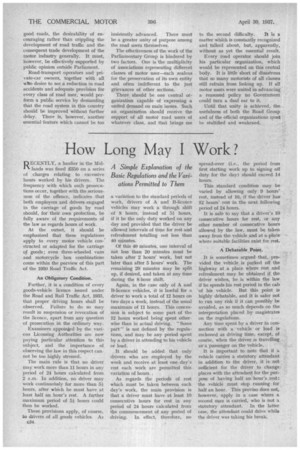How Long May I Work?
Page 92

If you've noticed an error in this article please click here to report it so we can fix it.
A Simple Explanation of the Basic Regulations and the Variations Permitted to Them
DECENTLY, a haulier in the Midi% lands was fined £350 on a series of charges relating to excessive hours worked by his drivers. The frequency with which such prosecutions occur, together with the seriousness of the offence, indicates that both employers and drivers engaged in the carriage of goods by road should, for their own protection, be fully aware of the requirements of the law as regards hours of work.
At the outset, it should be emphasized that these regulations_ apply to every motor vehicle constructed or adapted for the carriage of goods; even three-wheeled vans and motorcycle box combinations come within the purview of this part of the 1930 Road Traffic Act.
An Obligatory Condition.
Further, it is a condition of every goods-vehicle licence issued under the Road and Rail Traffic Act, 1933, that proper driving hours shall be observed. Failure to do so may result in suspension or revocation of the licence, apart from any question of prosecution in the ordinary way.
Examiners appointed by the various Licensing Authorities arc now paying Particular attention to this subject, and the importance of observing the law in this respect cannot be too highly stressed.
The main rule is that no driver may work more than 11 hours in any period of 24 hours calculated from 2 a.m. In addition, no driver may work continuotisly for more than 51 hours, after which he must have at least half an hour's rest. A further maximum period of 51 hours could then be worked.
These provisions apply, of .course, to drivers of all goods vehicles. As c,„34
a variation to the standard periods of work, drivers of A and B-licence vehicles may work a through shift of 8 hours, instead of 51 hours, if it be the only duty worked on any day and provided that the driver be allowed intervals of time for rest and refreshment totalling not less than 40 minutes.
Of this 40 minutes, one interval of not less than 20 minutes must be taken after 2 hours' work, but not later than after 5 hours' work. The remaining 20 minutes may be split up, if desired, and taken at any time during the 8-hour shift.
Again, in the case only of A and B-licence vehicles, it is lawful for a driver to work a total of 12 hours on two days a week, instead of the usual maximum of 11 hours. This concession is subject to some part of the 12 hours worked being spent other. wise than in actual driving. "Sonic part" is not defined by the regulations, and may be any period spent by a driver in attending to his vehicle or load.
It should be added that only drivers who are employed by the week and receive at least one-day's rest each work are ,permitted this variation of hours., As regards the periods of rest which must be taken between each day's work, the main provision is that a driver must have at least 10 consecutive hours for rest in any period of 24 hours calculated from the commencement of any period of driving. In effect, therefore, no spread-over (i.e., the period from first starting work up to signing off duty for the day) should exceed 14 hours.
This standard condition may be varied by allowing only 9 hours' rest, instead of 10, if the driver has 12 hours' rest in the next following period of 24 hours.
It is safe to say that a driver's 10 consecutive hours for rest, or any other number of consecutive hours allowed by the law, must be taken away. from the vehicle and at alilace where suitable facilities exist for rest.
A Debatable Point.
It is sometimes argued that, provided the vehicle is parked off the highway at a place where rest and refreshment may be obtained if the driver wishes, he is within the law if he spends his rest period in the cab of his . vehicle. But this point is highly debatable, and it is safer not to run any risk if it can possibly be • avoided, as so much depends on the interpretation placed by magistrates on the regulations.
Any time spent by a driver in mintnectiort with a vehicle or load is reckoned as driving time, except, of course, when the driver is travelling as a passenger on the vehicle.
• It is important to note that if a vehicle carries a statutory attendant in addition to the driver, it is not sufficient for the driver to change places with the attendant for the purpose of having half. an -hour's rest : the vehicle must 'stop running for half an hour. This proviso does not, however, apply in a case where a second man is carried, who is not a statutory attendant. In the latter case, the attendant could drive while the driver was taking his break.








































































































































































